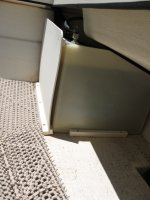I have (had) the "plain old cleat screwed to the hull" style in my 2002. I have only really looked at photos of the newer boats, but it looks to me as though they started fiberglassing the cleats to the hull in the mid 2000's sometime. So it's reasonable to think yours are, if they look that way. I don't know what was used to form the "body" of the cleat (various possibilities include foam, wood, fiberglass, etc.).
I believe that when CD went to the flat, "permanent" cockpit sole that the drop-in unit (glued to the hull) included a molded pan/cleats for the fuel tanks. In that case I would guess the "cleats" are part of the molding (i.e. humps in the mold) but I'm not sure. This would probably be fairly obvious when looking at it in person.
Perhaps your 2006 is of the era with the rounded cockpit sole like mine (i.e. it is the hull "top"), but the improved cleat design (which looks like some sort of cleat or form fiberglassed to the hull). If you do have this then I would say all is well, with the possible exception that if the cleat form is, say, wood - and if there are screws into it - then it may have taken on water. Still, the fiberglass would likely be all that is needed for strength once it has cured (as with a stringer), so even if the wood (if it exists) rotted the cleat shape would still be viable. One might want to re-evaluate any fasteners into it then (if there even are any).
I took out my Starboard™ cleats and overdrilled/filled the holes, then went back in with a different design that utilized fiberglass angles bonded to the hull for the "cleats" (they double as anchors for the cover panels and the forward end of the hold-down straps), and footman loops bonded to the hull for the after side of the straps. In the original design, the straps were attached aft at the bottom of the tanks, and forward at the top of the free-standing cover panels.... talk about "wrong" leverage! Now the straps run from the hull/angles forward to the transom near the top of the tanks - a stronger arrangement.
I thought of a number of ways to re-do the tanks/cleats - just happened to choose the one I did for a few reasons, but there are quite a few "good" ways, I think.
Edit: By the way, here is a photo of the fuel tanks/cleats in my 2002 as purchased. These were cleats made of Starboard™ type plastic which were screwed directly into the hull core. There was some sealant (not much) (and I don't recommend this type of installation anyway), but a few things made it even less likely to work properly. One is that this type of plastic doesn't "take" sealant very well (although I have been experimenting with Starboard™ and butyl with pretty good results - although I still would not use it in this type of application), another is that Starboard "moves" a fair bit, and third is that while poly fuel tank mfgrs. recommend quite a bit of expansion clearance be left between the tanks and cleats, it doesn't look like C-Dory left any, and so when the tanks predictably expanded, they "levered" the cleats right out of the sole (as you can see). Luckily my boat had been stored indoors, but even still there was a slight amount of damp core I had to remove (the slope of the sole funneled any slight amount of water right into the holes).
Having the tank hold-down straps attached to the top of the cover panel (!) probably didn't help matters either.
If your cleats
don't look like this style, then there is a good chance they are the better type that may not need any re-doing.


